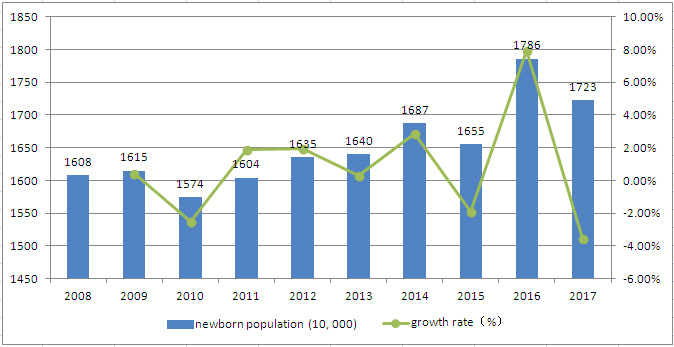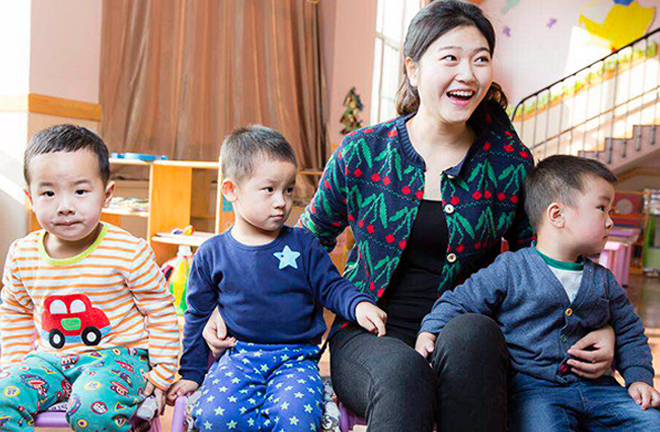Childcare system necessary to tackle low birthrate

China’s newborn population and growth rate (MA YUHONG/CSST)

Women who want to pursue career and the implementation of second-child policy call for the establishment of a childcare system.
“Women can’t pursue a career at all for about three years around pregnancy,” said 29-year-old Ran, who has reservations about giving birth even though she is at an ideal age to do so. She has been working in Shenzhen, Guangdong Province, for one year after graduating from Communication University of China and plans to get married next year. Ran and her boyfriend both have master’s degrees from renowned universities, but their monthly salaries total less than 20,000 yuan.
Last month, Ran went to her boyfriend’s hometown to celebrate Spring Festival. They paid for their travel and gift expenses by maxing out three credit cards and relying on Ant Financial, an online payment service provider. “Primary school students can live a better life than us,” Ran said helplessly.
According to data recently released by China’s National Bureau of Statistics, this couple’s experience is not uncommon. In 2017, the newborn population dropped by 630,000 relative to 2016 and the number of firstborn children decreased by 2.5 million in this period, reaching a total of 7.2 million. The ideal age for women to have a baby is between 20 and 29 years old. Declines in fertility can be attributed to a drop of nearly 6 million in the number of the women in this age group.
Ran is at an ideal age to have a baby, but she still hesitates to do so. In addition to daily expenses, Ran and her boyfriend need to pay 4,600 yuan for their mortgage monthly. The apartment has yet to be completed, so they also have to rent one for 3,000 yuan per month. “We are always in debt; even my parents have to support us with 1,000 to 2,000 yuan each month. How could we raise a child if we can’t get by on our own?” Ran said.
From Ran’s perspective, it would be difficult for a family to support a child without a monthly income as much as 50,000 yuan. Yang Juhua, a professor from the Research Center for Population and Development at Renmin University of China, said Ran’s concerns are justified. Public and government agencies have shifted the focus to senior care for a long time, while the issue of raising children has yet to be highlighted. In most cases, extended families currently cover the total costs of taking care of children, or as Ran put it “caring for children is a greater burden than giving birth to them.”
China has eased restrictions, and now couples are allowed to have two children. However, the lack of supporting measures still prevents a massive number of women from having a child. “Women now have no way to develop their career while managing domestic affairs at the same time,” said Yang. She calls for drafting policies as quickly as possible to ensure women’s welfare, such as greater maternity benefits and longer maternity leave. One important measure is to restore the childcare system in a short time.
Yang pointed out the necessity of a childcare system at last year’s forum on supply-side reform of pre-school education, saying that “The social welfare nursery system has been devastated in the process of economic structural reform, pushing people to seek help from their extended families if they want to have children. Problems such as high threshold for admission and expensive fees are becoming conspicuous,” she said.
In 2016, the China Population and Development Research Center conducted a survey on nursing service related to children under the age of 3 in 10 cities. The results showed that more than one-third of the research objects needed daycare service while a paltry of 4 percent of children was admitted to daycare centers.
Many daycare centers only teach children lessons without extracurricular counselling, so parents must pick up the children after work and help them finish may kinds of “school tasks” at home. This puts a greater burden on families. Furthermore, parents are concerned about their children’s security, and they have no idea whether children will be happy in daycare.
Nearly one out of three stay-at-home mothers in the survey had to resign their jobs because they have no one to help look after their children and more than three-fourths of the stay-at-home mothers are willing to go back to work if the circumstances improve. Yang said that it is controversial to push women to go back home in light of the country’s labor shortage.
People often compare China’s birthrate with that of Japan. Both affected by the Confucius culture, the two countries discourage births outside marriage. Also, Japan’s persistently low marriage rate has failed to make up for the vacuum created by rare cases of births outside marriage, leading to a low birthrate. In contrast, the divorce rate in the United States is still high at about 53 percent, but its birthrate has remained relatively high due to its large number of births out of wedlock, Yang suggested.
Unlike Japan, China has seen its marriage rate rise since 1996. In her thesis titled “Has China Really Suffered a Birth Crisis,” Yang said the statistics show that “in absolute terms, the marriage rate in China—about 10 per 1,000 in 2014—is far higher than that of South Korea, Japan and the United States, implying huge potential for fertility. The figure in South Korea was as low as 6 per 1,000 in the same year. Only an average of 5.3 couples out of 1,000 people in Japan chose to get married in 2013, the lowest rate in the four aforementioned countries.”
This thesis was published in 2015 and Yang concluded by saying that “It is still early to claim that China faces a severe birth crisis.” One year later, the 2016 China Statistical Yearbook released the results of a survey that sampled 1 percent of the country’s population, showing that China’s total fertility rate was 1.05 per 1,000.
By the time she received this interview last month, Yang had adjusted her view. In terms of the current circumstances, she claimed that “China will not undergo a birth crisis in a foreseeable future.”
“Compared with countries such as Japan and South Korea, a large proportion of Chinese people are still choosing to marry and have children,” Yang explained. Under the influence of Confucian culture, the idea of getting married and having children still prevails in China, and it will last for a long time. However, it remains uncertain whether more will forgo marrying or having children in the context of greater social modernization. Yang pointed to a number of modernized Nordic countries where fertility rates remain high and the total birthrate is holding steady at about 1.9 per 1,000 mainly due to their excellent policies supporting fertility. However, the situation in Italy and East European countries are totally different because of their lack of such support.
Fertility behavior obviously tends to become an individual choice in the diverse society, but individual choices would be influenced by the people around. In her article, Yang respectively calculated the population census data of 1990, 2000 and 2010, suggesting that the proportion of families without children stays low regardless of aspects of gender, location and era. Even though the figure has risen a lot in 2010, it was still lower than 2 percent. The number of “dual income, no kids (DINK)” families was 110,000 in 2001 and it climbed to 510,000 in 2005, according to the 2008 data of China Population and Economic Statistical Committee. The increasing number of DINK families has not translated into sharp increase in families without children because couples may give up the ideal of not having children later in their marriage for various reasons.
This year’s government work report also pays attention to the issue with an aim to “increase the supply of preschool educational resources through multiple channels and use the internet and other IT-based approaches to strengthen oversight over the whole process of childcare provision, making certain that parents can have peace of mind.”
It has multiple favorable effects for each family to have two children in terms of anti-risk consideration, long-term development as well as all family members’ individual growth, Yang suggested.
Ran’s boyfriend said they will plan to have a child after getting married in the next year. Their salary will increase by that time. “It’s going to be fun. A baby will liven up the life of the whole family. We will pull ourselves together when we see the lovely little thing after coming back from work,” he explained.
The article was edited and translated from China Youth Daily.
(edited by MA YUHONG)
